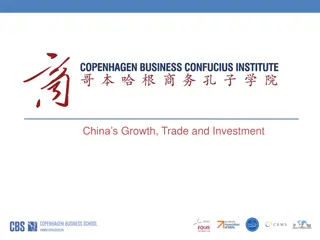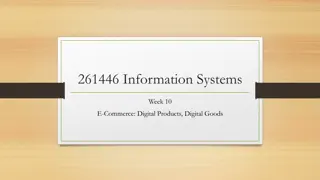
E-Commerce in China: Growth and Trends
China's e-commerce industry has seen exponential growth, with Singles Day sales surpassing Black Friday and Cyber Monday combined. The country's vast internet population and mobile payment adoption have fueled this surge, leading to a significant increase in e-commerce transactions and market value. Explore the various e-commerce classifications and the impact on China's economy.
Download Presentation

Please find below an Image/Link to download the presentation.
The content on the website is provided AS IS for your information and personal use only. It may not be sold, licensed, or shared on other websites without obtaining consent from the author. If you encounter any issues during the download, it is possible that the publisher has removed the file from their server.
You are allowed to download the files provided on this website for personal or commercial use, subject to the condition that they are used lawfully. All files are the property of their respective owners.
The content on the website is provided AS IS for your information and personal use only. It may not be sold, licensed, or shared on other websites without obtaining consent from the author.
E N D
Presentation Transcript
E-Commerce in China 16 November 2017
Singles Day 2017: US$25bn (RMB168.2bn) x4 than Black Friday and Cyber Monday Spending on Alibaba increased by approx. 40% on 2016 2016 s sales figure reached in 13 hours $1bn spent in the first two minutes after midnight.
Chinas E-commerce Statistics in 2016 Network shopping users: 467 million 2016 China: Internet population reached 731 million and Internet penetration reached 53.2% 2016 USA: Internet population reached 286 million and internet penetration reached 88.5% 2016 China: mobile Internet users reached 695 million and the proportion of Internet users who pay online via mobile phones reached 67.5%. Value of E-commerce transactions: RMB 26.1 trillion e-commerce transactions increased by 19.8% YOY 2016 34% increase 2012-2016.
Chinas E-commerce Statistics in 2016 The e-commerce Industry reached RM 950 trillion Support services in the field, electronic payment services, logistics services, electronic authentication etc.
Contents 1.Concept of E-commerce 2.China s E-commerce development 3.China s E-commerce Law
What is E-commerce? The process of buying, selling, or exchanging products, services, or information via computer networks. The way we use the term e-commerce can however depend on the sector we are engaged in. Communication fields: delivery of information and products over networks Commercial contexts: online buying and selling. e-commerce industry: Logistics, back office, warehousing, etc.
E-commerce Classifications B2B (business-to-business): allows e-business to collaborate, partner, and share research and complex data with other businesses. B2C (business-to-consumer): turns browsers into buyers, building customer loyalty. C2B (consumer-to-business): The business responds to the consumer s requested product and its price. C2C (consumer-to-consumer) business: Online auction sites are the most common forum for C2C e-commerce. B2G (business-to-government): Businesses that bid on government contracts use the B2G business model. G2C (government-to-consumer): allows to interact with government agencies online. Intermediately: platforms which bring buyers and sellers together.
Direct vs. Indirect e-Commerce Indirect: electronic ordering of tangible goods. Requires the use of traditional delivery channels. Direct: intangible goods and services. Online ordering, payment and delivery of goods or services such as films/music.
Traditional commerce vs. E-commerce Comparator Traditional commerce E-commerce Website Preparing to trade Physical trade outlet Trade negotiation process Oral consultation or paper Electronic trade documents Execution of the contract Commercial contract in written form Check box/electronic signature Payment Card, cheque or cash Paypal/Alipay or cash on delivery
Traditional commerce vs. E-commerce Impact on organizational management Company s interactions with customers changes: Labour and resources will change. Less shop workers, more delivery personnel. No time or geographical restrictions (in theory)
E-commerce Trends in China The 2016 general report of China electronic commerce development issued by China s Ministry Of Commerce shows a steady rise in: number of China's online shopping users, the trading volume of e-commerce transactions the number of e-commerce practitioners Online retail transaction volume rural network retail transaction volume e-commerce services revenue third-party Internet payment
E-commerce Trends in China The e-commerce silk road: Overseas suppliers using cross-border e-commerce to enter the Chinese market, e.g. forgoing traditional flagship stores. Chinese enterprises using cross-border e-commerce platform to create their brand and to sell products. Cross-border e-commerce infrastructure, e.g. overseas warehouses, overseas operations centre and overseas e-commerce parks.
E-commerce Trends in China The 13th 5 Year Development Plan for e-commerce Jointly issued by Ministry of Commerce, Office of the Central Leading Group for Cyberspace Affairs and State Development and Reform Commission Duel objectives: economic growth and social development By 2020: business transactions through e-commerce platforms: RMB 40trillion online retail sales: RMB 10 trillion related workforce: 50 million
E-commerce Trends in China The 13th 5 Year Development Plan for e-commerce To be achieved by focuses on 4 major aspects constructing the e-commerce information infrastructure nurturing new business forms and emerging markets developing the e-commerce market building up new order for e-commerce
E-commerce Trends in China The 13th 5 Year Development Plan for e-commerce The plan also sets out how the authorities will indirectly promote and protect the e-commerce industry: prohibiting administrative organs from using their powers to eliminate or limit competition on the e-commerce market preventing trade monopolies cracking down on unfair competition activities.
E-commerce Trends in China Southwest China Chengdu/Chongqing Cross-border E-commerce Public Service Platforms Chongqing launched 2015 Chengdu launched February 2016 one-stop shop : customs clearances, commodity inspections, tax rebates and foreign exchange settlements.
E-commerce Trends in China: Southwest Alilbaba Logistics base is in Chongqing. Aims to deliver goods to its customers within 24 hours Set up Loan and Guarantee companies in Liangjiang New Area Strategic cooperation agreement with the Chongqing Municipal Government which will include cross border e-commerce. Regional Products QR code stores information about a household's farm produce, which can be shared on the internet and reach buyers countrywide. Guizhou province: region specialty products sold online reached RMB 200,000
E-commerce Trends in China: Southwest JD.com Building 150 cargo airports in Sichuan Province for drone delivery. Current drones can carry 50kg and aim to carry 500kg in 3 years All county-level towns expected to be covered in 3 years Chongqing-Europe Railway Mail service to Germany piloted in May 2016 5,000 cargo trains running between China and Europe annually by 2020 Parcels will arrive in Germany at least 20 days faster than if sent by sea. The cost is 1/5 of that by air
Timeline of Foreign Investment Regulations in this Area Foreign investment in e-Commerce platforms. Does not relate to: brands selling through its own website (filing with the Ministry of Industry and Information Technology still required) using a third party platform. Internet Content Provider license still required for other business services, e.g. travel, search providers, video and image services, advertising and classifieds.
Timeline of Foreign Investment Regulations in this Area March 2011: The 12th Five Year Plan contained move from an export-led manufacturing economy to a consumer economy. January 2014: 55% Foreign Invested Entities (FIE) permitted in the Shanghai Free Trade Zone (SHFTZ) with nationwide reach (increase from standard 50%) January 2015: 100% foreign ownership in the SHFTZ permitted.
Timeline of Foreign Investment Regulations in this Area April 2015: 2015 Foreign Investment Catalogue specifically exempts e- commerce business from the 50% foreign investment cap in Value Added Telecommunications Services ( VATS ) businesses June 2015: SHFTZ liberalization expanded nationwide. The license procedure is also simplified. Heiwado (China) Co Ltd first WFOE to obtain license in August 2016 27 December 2017: Draft e-Commerce Law published. October 2017: Draft e-Commerce Law second reading
Draft e-Commerce Law First Draft released 27 December 2016. Public comments stage completed 26 January 2017. Second draft now under consideration. Includes both domestic e-commerce and cross border e-commerce Includes platforms: legal person or other organization providing cyber space, virtual business premises, transaction matching, information distribution and other services to two or more parties to an e-commerce transaction so that the parties may engage in independent transactions and e-commerce operators : any natural or legal person or other organization, other than an e-commerce business entity, that sells goods or provide services through the Internet or other information networks.
Draft e-Commerce Law Does not apply to financial products and services, or services of broadcasting audio and video programs. The draft law covers a multitude of issues, and we will only cover some of these today.
Draft e-Commerce Law Accountability Registration: e-commerce operators must be registered with the industry and commerce authorities. User real name registration: Platform users should provide their genuine identity and valid contact information. E-commerce third party platform shall examine and register business operator s information. Privacy: The e-commerce entity should take appropriate safeguards to protect user s personal information.
Draft e-Commerce Law Electronic Payments: Includes rights and obligations of payment institutions, electronic payment service provider and recipient, pay confirmation, wrongful and unauthorized payments. For example, the online payment service provider will automatically be held liable for losses caused by unauthorized payment, unless it can prove that such losses are caused by the recipient of the online payment service.
Draft e-Commerce Law Logistics: If there is a delay in the delivery, damage or loss, the logistics service provider must indemnify the customers. Where express logistic services are provided by franchise, the franchisee and franchiser shall be jointly liable.
Draft e-Commerce Law Consumer Protection Service Agreements: Service agreement and trade policies to regulate relationship with customers and operators. Must include provisions on termination, quality guarantees and consumer protection. Clearly displayed and accessible on the platform website and copies must be filed with the authorities. Operator/customer must be given the option to terminate if amendments are made.
Draft e-Commerce Law Unfair Competition Lists the prohibited activities that constitute unfair competition and undermine the credit trading system. Fines of up to RMB 500,000, business licenses can be revoked. IP rights owners can report to the platform IP abuses by e- commerce operators. Protective Measures must be taken Do these measures go far enough?
Draft e-Commerce Law Consumer Protection. E-commerce operators are responsible for the quality of goods and services provided. E-commerce services providers are responsible for the service provided. Third Party Platform: Jointly liable for damages caused to consumers due purchasing goods or receiving services. E-commerce platform also be liable if they fail to provide the consumer with the e-commerce operator s valid identity and contact.
Draft e-Commerce Law Cross-Border Increased digitalization and convenience level of customs clearance, tax collection, inspection and quarantine procedures Electronic receipts and certificates will have the same legal force as paper ones. business operators carrying out cross-border e-commerce activities shall be subject to PRC regulations product quality and labelling not addressed.
Draft e-Commerce Law Implementation No implementation date has been set August 2017 the authorities asked e-commerce platforms to carry out self-examination and correction .
Competition Law Revisions to Anti-Unfair Competition Law introduced 4 November 2017 To take effect 1 January 2018 encompass the entire breadth of internet commerce, e.g. online goods to movie tickets to food delivery The new provisions include: ban on fake sales or brushing ban on click farms ban on deleting bad comments ban on employing people to leave good comments
Competition Law Penalties online merchants that fake sales or feedback can be fined up to RMB 2 million or lose their business license.
Other Legal Matters Establishment of company/WFOE License Logistics Human resources IT support Intellectual Property protection: brand, website design etc. Drafting terms and conditions Data privacy Tax Import/export duties
Final Word If you do not sell your goods online someone else will Someone in your company should be tasked with monitoring sites for IPR infringements






















